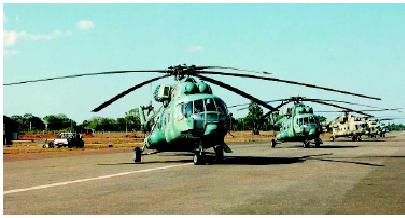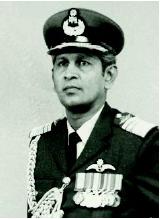SLAF History : Old Wings New Wings

 The first three Mi-17 helicopter transports joined the fleet in 1993. The Mil Mi-17 tactical transport twin engine helicopter came to the SLAF inventory with an impressive pedigree. Of an extremely rugged design, the Mi-17 had been flying from the early 80's.
The first three Mi-17 helicopter transports joined the fleet in 1993. The Mil Mi-17 tactical transport twin engine helicopter came to the SLAF inventory with an impressive pedigree. Of an extremely rugged design, the Mi-17 had been flying from the early 80's.Dependable and battle proven with a significantly higher payload than the Bell 212/412s, the Mi-17 was soon to become an admired favourite of the SLAF, and a real work horse along with its cousin the Mi-24 attack helicopter, which joined the fleet later. Another three IA58 Pucara aircraft were also acquired, enhancing further the Air Force's ground attack capabilities.
The arrival of the Mi-17 helicopters prompted the formation of No. 6 Helicopter Squadron on 15th March 1993, at Katunayake. However, the services of the Mi-17 were felt to be too far away from the battle zones and the squadron relocated to SLAF, Vavuniya on 29th April 1993. Going retro , in a manner of speaking, Commander, Air Marshal Terry Gunawardena was able to complete the SLAF Museum, which was formally declared open by the Hon Prime Minister, D.B. Wijetunge on 3rd March 1993. This was also the day that the SLAF officially celebrated its 42nd Anniversary.
A rather unique if daring event took place at the opening ceremony. Wg Cdr J.L.C. Salgado, then attached to the Transport Squadron at Ratmalana climbed into the cockpit of a Beech Super 80 aircraft for the first time in his life, with the then CO of the AP & SU, Wg Cdr O.D.N.L. Perera as his co-pilot, and after going through the check list, proceeded to take off! He then executed some choice low level flying in celebration of the event! In the medical field a landmark event saw the appointment of Wg Cdr Y.K. Ratnayake as Commanding Officer of the Air Force Hospital, Katunayake. She was the first lady CO of the Hospital and the first lady CO to be appointed within the SLAF!
 A Change of Command and other Changes!
A Change of Command and other Changes!1994 saw a change at the top at SLAF Air Chief Marshal Gunawardena retired on 16th February and was succeeded by Air Marshal Oliver Ranasinghe
On the 17th of the same month. Commander Ranasinghe's period at the helm of affairs yielded some important changes and developments.
Flying Operations and Fleet Enhancements
In 1994, No. 4 Helicopter Wing was split into two Squadrons namely 401 and 402. No. 401 Squadron took charge of operational flying requirements and pilot training, and was located at SLAF, Hingurakgoda. No. 401 Squadron had the Bell 212 and Bell Jet Ranger helicopters in its fleet. No. 402 Squadron remained at Katunayake and flew Bell 412 and Bell Jet Rangers, largely catering to VIP movement.
Another change was the repositioning of No. 5 Jet Squadron to China Bay, thus bringing the F7s closer to operational areas with the attendant benefits of quicker response to demands from the conflict zones. In 1994, another Pucara and three Mi-17 helicopters joined the SLAF. The Mi-17s went into No. 6 Squadron and at a total strength of six aircraft, began to provide yeoman service in the area of tactical transport, in the North and East. The SLAF carried out flying support actions for 20 missions in the North and East in 1994.
Further Development
The latter half of 1994 saw the holding of Parliamentary and Presidential Elections in Sri Lanka. The SLAF provided its services in the areas of internal security and assistance to civil authorities during these elections. Air Force ground troops were also committed in the areas of Trincomalee, Vavuniya and Ampara. In Ampara, the Army relieved the SLAF force and their presence on the ground was no longer necessary. A little known part of Air Force life is the Printing Section, staffed largely in 1994 by airmen who had been so unfortunately disabled in the war.
This little unit had been busily producing the Guwan Sandeshaya a monthly magazine of Air Force news. In September 1994 the unit was provided with an Officer I/C and thus commenced regular training for all Airmen. The printing unit was improved in the ensuing years with a guillotine in 1995 and an enlarger in 1997. A colour lab also came into being and more airmen and women were added to the cadre.
Hostilities Resumed The new Government of the People's Alliance made their agenda known with a negotiated ceasefire and commenced further negotiations and discussions in a bid to resolve the conflict. The process began in January 1995. However, after 3 months, the talking ended and fighting began. The naval vessels in Trincomalee Harbour were attacked on 19th April. Thus began a particularly intense and bloody period in the war!














